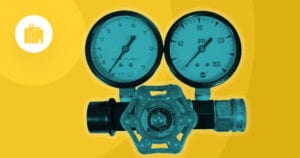
In a matter of weeks, COVID-19 altered how we operate in our daily lives. Similarly, manufacturers were instantly impacted, with 75 percent citing supply chain disruptions and 53 percent requiring a change in operations. Most were deemed ‘essential businesses,’ yet their operations continuity was significantly interrupted by volatile demand, travels bans, and workspace restrictions due to health and safety issues.
Immediately concerns arose on the operations side with factories being taken offline without a means for workers to maintain uptime or access production lines, machines, and other assets in facilities. Manufacturers with complex products out-in-the-field also faced service challenges for commitments to uptime. End-users of these products in mission-critical environments, whether it’s critical infrastructure, factories creating medical products, or hospitals treating COVID-19 cases, couldn’t afford the downtime of this equipment.
In several of these situations, information was largely inaccessible; real-time performance data of a machine or 2D paper-based standard operating procedures largely resided in a factory’s on-premises server closet or a worker’s file cabinet. This type of information disconnect quickly became problematic in maintaining business continuity in COVID-19’s ‘new normal.’
However, forward-thinking manufacturers with ‘Remote Everything’ mindsets were as prepared as they could be for the unexpected pandemic. Remote connectivity, accessibility, monitoring, and management capabilities enabled digital twins of physical facilities and products to alleviate COVID-19 operating and work constraints. This provided a smoother transition for many into the new normal than those without these abilities.
Remote Access for the Uptime of Fleets of Products
Manufacturers have traditionally lacked insight after the point-of-sale transaction into the black box customer environments that their products operate in. However, with the Industrial Internet of Things (IIoT), around 50 percent of manufacturers now have connected products, according to Capgemini. Embedding IIoT connectivity into the manufacturer’s massive deployments of new and old products unlocks immense value, which proved true during COVID-19.
Uptime of equipment in mission-critical environments was fundamental during the crisis. With IIoT-enabled remote monitoring, manufacturers and service teams can aggregate, manage, and analyze performance data from assets out in the field without major service operations, including truck rolls.
Remote Monitoring
Remote monitoring is the top Applications for connected products and was largely turned to maintain uptime during COVID-19. It provides important operational visibility of deployed products and a benchmark to build on additional functionality for device management, access, control, and analysis. Extending beyond remote monitoring, customers can remotely diagnose and service equipment by triggering remote actions such as troubleshooting or software package updates.
These Applications were critical for maintaining product uptime and enabling remote service when field technicians could not travel on-site during COVID-19. Preemptive service actions decrease service interruptions for patient treatments in hospitals, where resources and capacity were already greatly constrained during COVID-19.
In some instances, technician truck rolls will still be necessary to resolve issues and maintain products’ uptime in these critical environments. The equipment can be complex in healthcare, which creates complicated, unpredictable, and resource-intensive service actions. On average, healthcare equipment has a first visit repair time of three hours, and 62 percent of truck rolls face incidents on site.
With root cause analysis through IIoT, a technician is preemptively provided with an updated service dossier, including incident details and the required tools, service parts, and other information to remediate actions quickly. Service teams were better optimized during the crisis from this insight and circumvented worker travel constraints and bandwidth issues to drive higher service efficiencies.
The ability to remotely resolve and accurately triage service issues greatly reduces product downtime and interruptions to end-users leveraging these medical products, which have proven pivotal in supporting the fight against COVID-19.
Remote Operations for Production Capacity Optimization
Factories and industrial facilities faced not only supply chain resiliency obstacles from COVID-19 but also unique workspace constraints. Many are essential businesses that needed to operate but were pressed with health risks and safety regulations, such as social distancing, sanitization, workspace congestion, and travel bans.
Orchestrating manufacturers’ already spread-thin personnel and scheduling resources within these parameters presents significant operational capacity challenges. A factory operator may not be able to access the HMI on a machine or physically visualize a malfunctioning piece of equipment in a facility where production bottlenecks are frequent.
‘Remote Everything’ capabilities expand to these on-site industrial assets and lessen the need for operators to physically intervene with these machines or even be on-site in some instances. With the IIoT providing a bi-directional link, the operator can access the machine’s health and other KPIs, analyze trending performance data that predict downtime and system failures, and enable remote actions through a virtual interface machine’s digital twin.
COVID-19 has created intermittent demand across the supply chain, forming unpredictable production volatility and shifting capacity requirements for manufacturers. The need to quickly respond to customer orders and optimize production lines based on fluctuating demand can be greatly expeditated through remote connectivity.
Remote capabilities drive real-time actionable insights and automated actions for manufacturers to improve these production line assets’ availability and reliability. Manufacturers can greatly improve efficiencies and throughput and lower energy costs through this IIoT-enablement while maintaining fewer physical interventions to the production sites.
Manufacturers capable of remotely accessing production lines, machinery, and other industrial assets on- and off-site greatly alleviated the seemingly insurmountable supply chain, downtime, and workspace challenges COVID-19 presented.
Digital Platforms Expedite ‘Remote Everything’
Most manufacturers recognize the need for remote IIoT capabilities with the increasing prevalence of connected products, and 91 percent invest in digital factories. However, some mistakenly attempt to build the capabilities themselves, known as ‘do-it-yourself’ initiatives, which take around 2.5 years and exhaust resources. Others invest in one-off technologies and tools for factory and product-specific enablement without the entire organization’s best interest in mind.
Investing in third-party remote capabilities with platforms that wrap IIoT connectivity around heterogeneous industrial environments and extend applications across the enterprise greatly reduces time to value digital transformation programs. Rapidly rolling-out remote monitoring, management, and service Applications that scale across the enterprise have moved to the top of CxO’s strategic agendas with the COVID-19 crisis restricting access to critical information and disconnected industrial assets.
‘Remote Everywhere’ mindsets will drive IIoT adoption in both times of crisis and for strategic differentiation. Aligning with a digital ally with industrial experience and a partnership ecosystem provides the most efficient path to adopt these remote capabilities. Many manufacturers with this mindset pre-crisis were better positioned to maintain continuity and be better equipped to handle unpredictable events in the ‘new normal.’





 Related Podcast Episode
Related Podcast Episode




 Related Applications
Related Applications



 Latest IoT News
Latest IoT News








